Erik Satie wore suits of chestnut velvet. Steve Jobs wore jeans and a black turtleneck.
What about you? If you had to choose one style of clothing, one outfit, one ‘look’ to wear every day for the foreseeable future, what would it be?

Old-Fashioned Fruitcake
Erik Satie wore suits of chestnut velvet. Steve Jobs wore jeans and a black turtleneck.
What about you? If you had to choose one style of clothing, one outfit, one ‘look’ to wear every day for the foreseeable future, what would it be?
Today I thought I would indulge my stationery-geek side (and, hopefully, yours) by introducing you to my writing instruments. (No, I haven’t given them names. Yet.) Illustrated mostly with other people’s pictures, because mine aren’t much to look at.
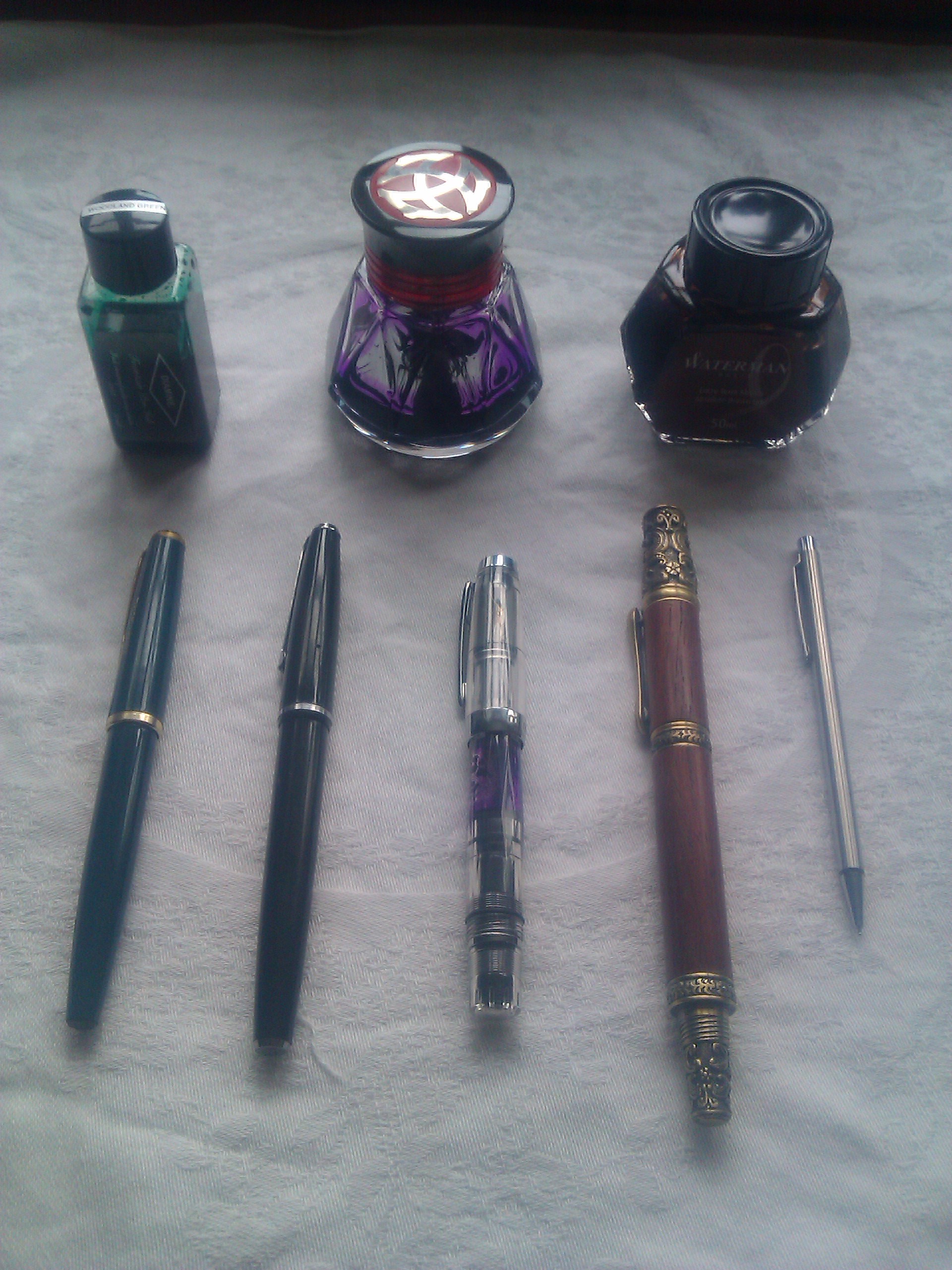
First in seniority is the green Faber-Castell (with goldish accents) which I found, fully functional, in a box of disused fountain pens which was passed on to me by my husband’s family when they found I was interested in such things. (Now that’s the kind of family you want to marry into.) It was this pen that inspired my love for piston-filling fountain pens, and I used it to write the epically large first draft of my WIP. These days it contains Diamine Woodland Green and I use it mostly for writing in my spiritual diary.
From the same box of fountain pen goodness came the Platignum Shorthand Pen – black with silver accents. It uses a rubber sac with a squeezy bar to fill, with the downside of not being able to tell how much ink is left in it. Despite that drawback, it is rapidly becoming my go-to pen for general writing – shopping lists, to-do lists, notes – because it has such a fine line and isn’t too wet, so works well on general-purpose paper. It currently contains Waterman’s Havana Brown (now called Absolute Brown for Absolutely no reason that I am aware of.)
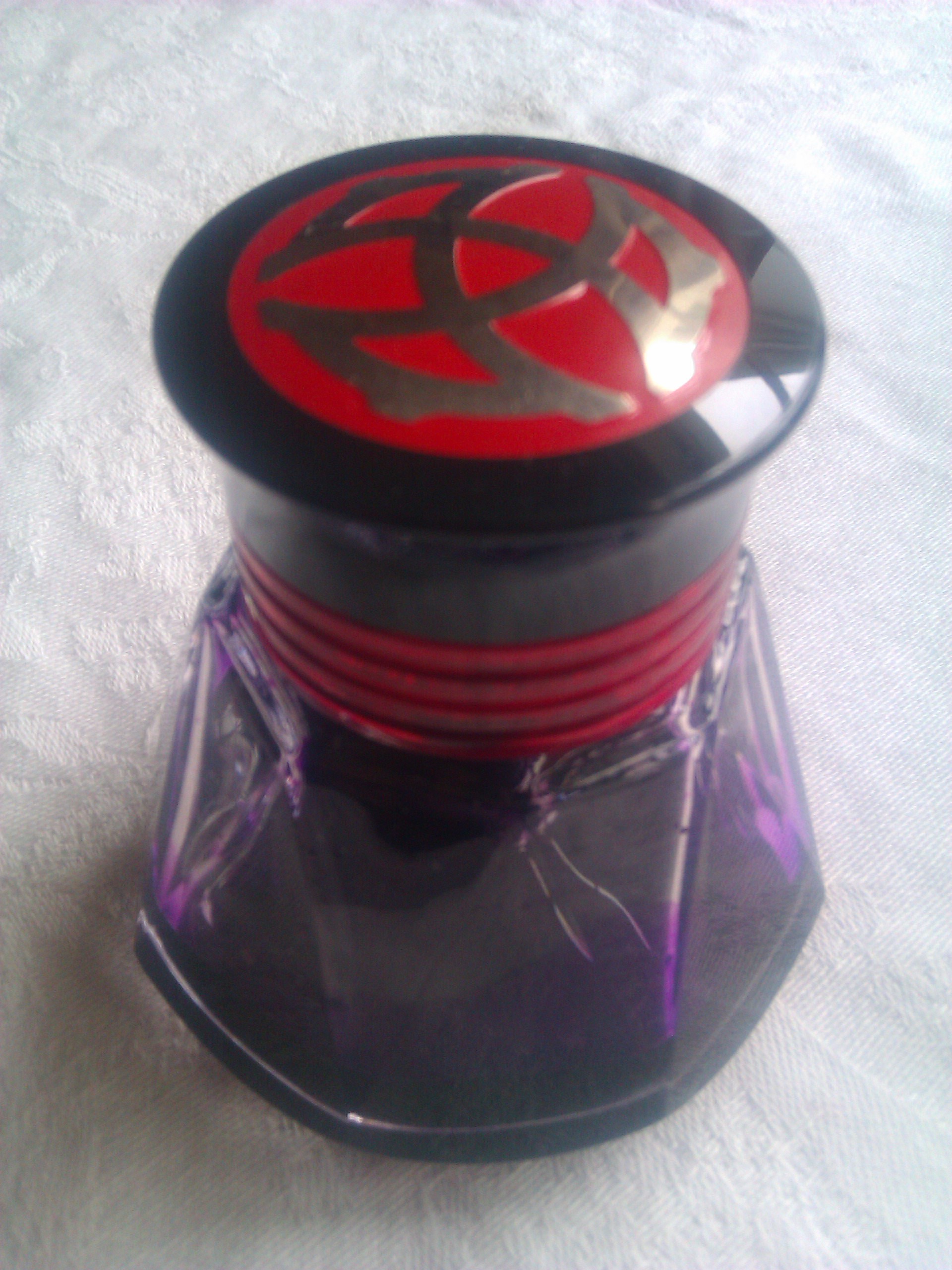
The next to enter my life was my first ever new pen: the TWSBI Mini, which I bought to reward myself for slogging through all 158,840(ish) words of the first draft. It’s another piston-filler; in fact, if you have a TWSBI ink bottle – which I do – the pen’s barrel can refill straight from the socket in the top of the bottle lid, without any of the messiness inherent in dipping a nib into the bottle.
Unlike all my other pens, it also has a clear barrel, so you can see how much ink is left at all times. This also makes it an ideal pen for using with coloured inks. Currently it contains Diamine Majestic Purple, thematic colour of ye olde WIP, and is used for notes and records thereon and thereof.
The fourth of my pens, a gift from my parents last Christmas, is undoubtedly the most aesthetically impressive to behold. (You can’t just look at this one. You have to behold it.) Almost baroque in its ornateness, it features a barrel of Papua New Guinean rosewood, and so much metal ornamentation I got pulled out of line and had my bag searched when going through airport security with it. It’s quite a heavy pen, so I don’t use it for long pieces of writing. It is best for using a) when one feels like being impressive and b) when one wishes to draw a satisfyingly final line through items on to-do lists.

It’s rather a wet nib (so it doesn’t care for everyday paper) and has a smallish (piston-filling) ink chamber, considering the overall size of the pen. It is also filled with my general use brown ink.
Finally, and most recently arrived in my collection of writing implements, there is a pencil. A reusable (i.e. mechanical) one, naturally, for the sake of the environment if not my laissez-faire attitude to getting up to sharpen things. It’s a Pilot Birdie, slim and silver and, well, small. It uses 0.5mm leads and is itself only 5mm thick. It’s designed for use as a notebook pencil, but hey – I’ve got small hands, and it sticks out far enough behind my hand to be comfortable to use. I got mine second-hand, so there’s not much eraser left, but that’s all right. I mostly wanted a pencil instead of a pen for my morning pages (which I’m thinking of shifting to nighttime) so that if I fall asleep mid-page I don’t wake up bathed in Havana Brown.
Remember that scene in Cool Runnings when they arrive in Calgary and Sanka rushes back into the terminal to put on everything in his bag, followed by the bag? Thirteen years ago, that would have been me arriving in New Zealand, had my grandmother not met us at the airport with a better bag: a bag full of woollies, knitted with her own two hands.
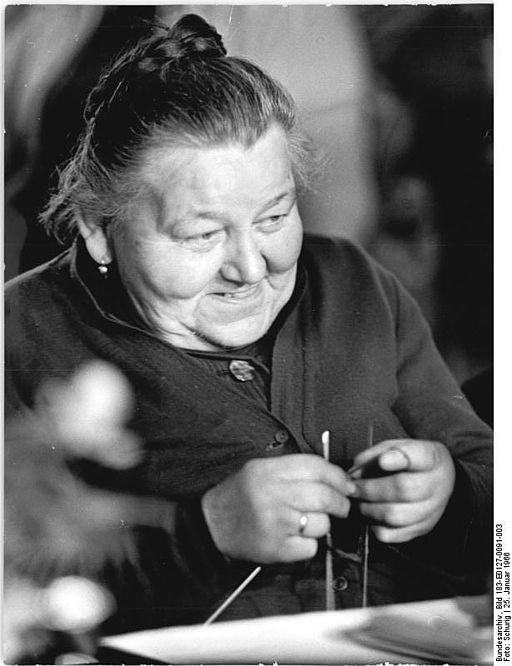 That bag included a grass-green guernsey for me, a garment which I immediately put on and have worn for large parts of every year since. When it was two years old, I wore it to said grandmother’s funeral, along with some of my similarly guernseyed cousins (she was a very productive woman, my gran). I have done many wardrobe clear-outs over the years, of varying levels of drasticitude, but I have never considered getting rid of my guernsey.
That bag included a grass-green guernsey for me, a garment which I immediately put on and have worn for large parts of every year since. When it was two years old, I wore it to said grandmother’s funeral, along with some of my similarly guernseyed cousins (she was a very productive woman, my gran). I have done many wardrobe clear-outs over the years, of varying levels of drasticitude, but I have never considered getting rid of my guernsey.
So you can imagine my distress on noticing that the cuff was wearing thin at the fold. But we were in the middle of moving house, packing everything up and so on; hardly a good time to settle down to some mending. I did manage to go through the box of ancestral happiness which contained all the odds and ends of wool left behind by this same knitting grandmother, looking for matching wool to mend with. Alas, there was not so much as a scrap of the original yarn, but I pulled out a few greens and packed them separately, so as to have them to hand.
Imagine my horror, on one of our first mornings in this house, when I pulled the guernsey on and my finger went through a hole.
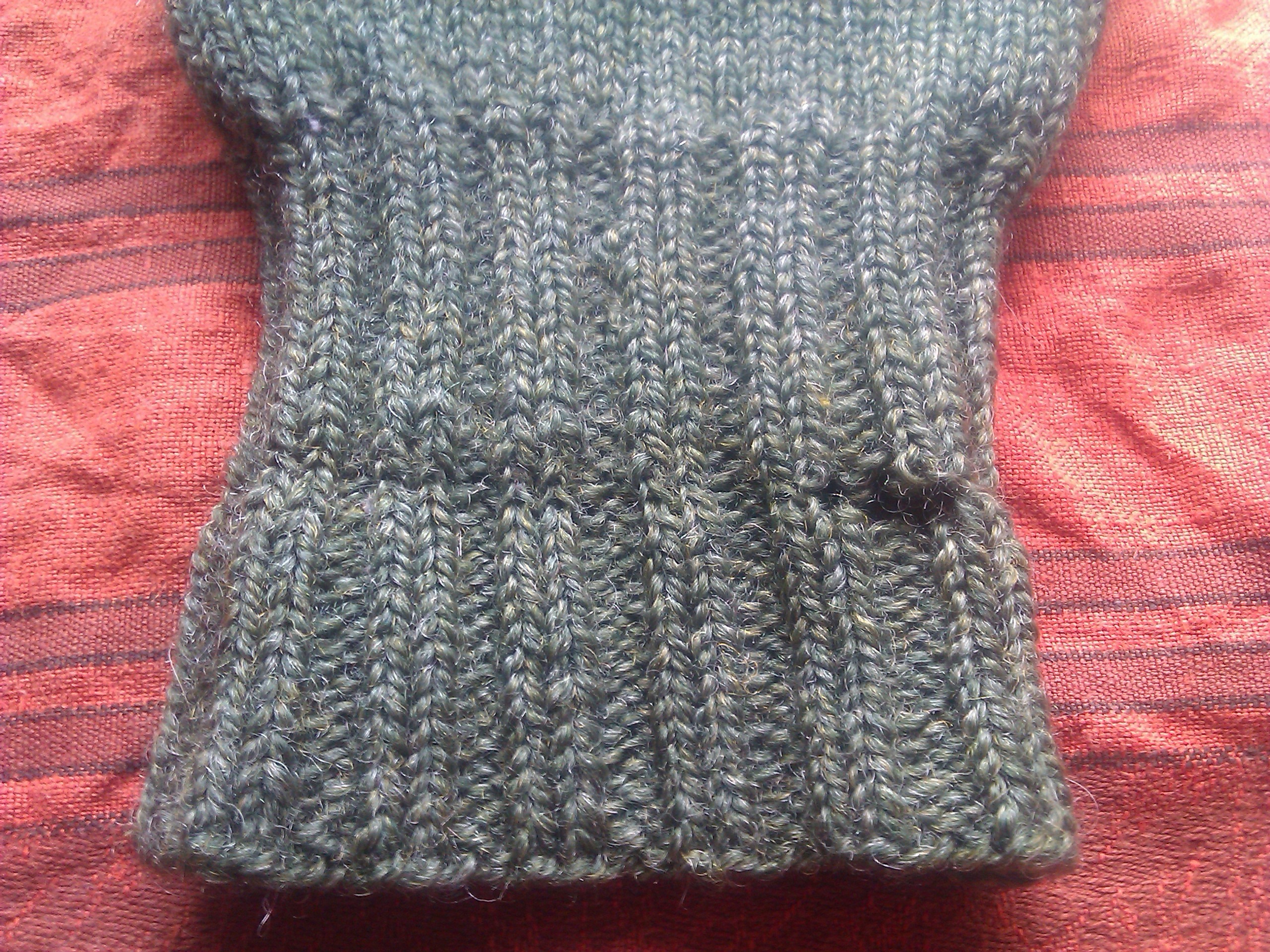
There was no time to be lost. I found the assortment of green yarns and compared them with the original to decide which was closest. There was one that was Close Enough to Do, I decided; no need to hit the shops before a mend could be undertaken. The next question was one of method. It may be “sleep that knits up the raveled sleave of care,” but for raveled sleave of guernsey you need some kind of a darn.
Results having finally come through (or rather worn through) from the sock-darning experiment, I thought I would go with the classic back-and-forth darn. One of my vintage handwork books recommends a sort of Swiss darning for holes in knitted things (there’s a tutorial here if you dare), but I quailed at the thought. I was by no means sure of my ability to execute it correctly – and the idea of taking scissors to the beloved garment brought me out in a cold sweat. This was no mere sock, after all. This was the last garment my gran ever made for me, and while there may be knitting where she has gone (I sure hope there is), they don’t allow for forwarding to the bereaved descendants.
The stakes were high. I gathered my materials from the various locations to which a state of partial unpackedness had spread them.

The actual darning wasn’t too much trouble, once I’d figured out a way to weave the needle in which didn’t leave long strands on the wrong side – or right side, if the cuff is folded back, though I doubt there is a right side for long unattached strands. There was more to do than I’d realized, however: the hole was small, but the eight-ply-worn-almost-to-lace section ran about halfway round the cuff. It took a while.
The problem with darning, as identified by Miss Mary Grant, is that it is not exactly mentally invigorating – but it does require you to keep your eyes on what you are doing. Happily, however, ears are not a necessary part of the darning equipage, and you can listen to music, download an audiobook from Librivox, or, like me, get your nearest and dearest to read aloud to you while you work. It tends to take longer than you think. Just when you reach the end of the patch with your up-and-downs, you realize now you have to do all the back-and-forths (or vice versa).
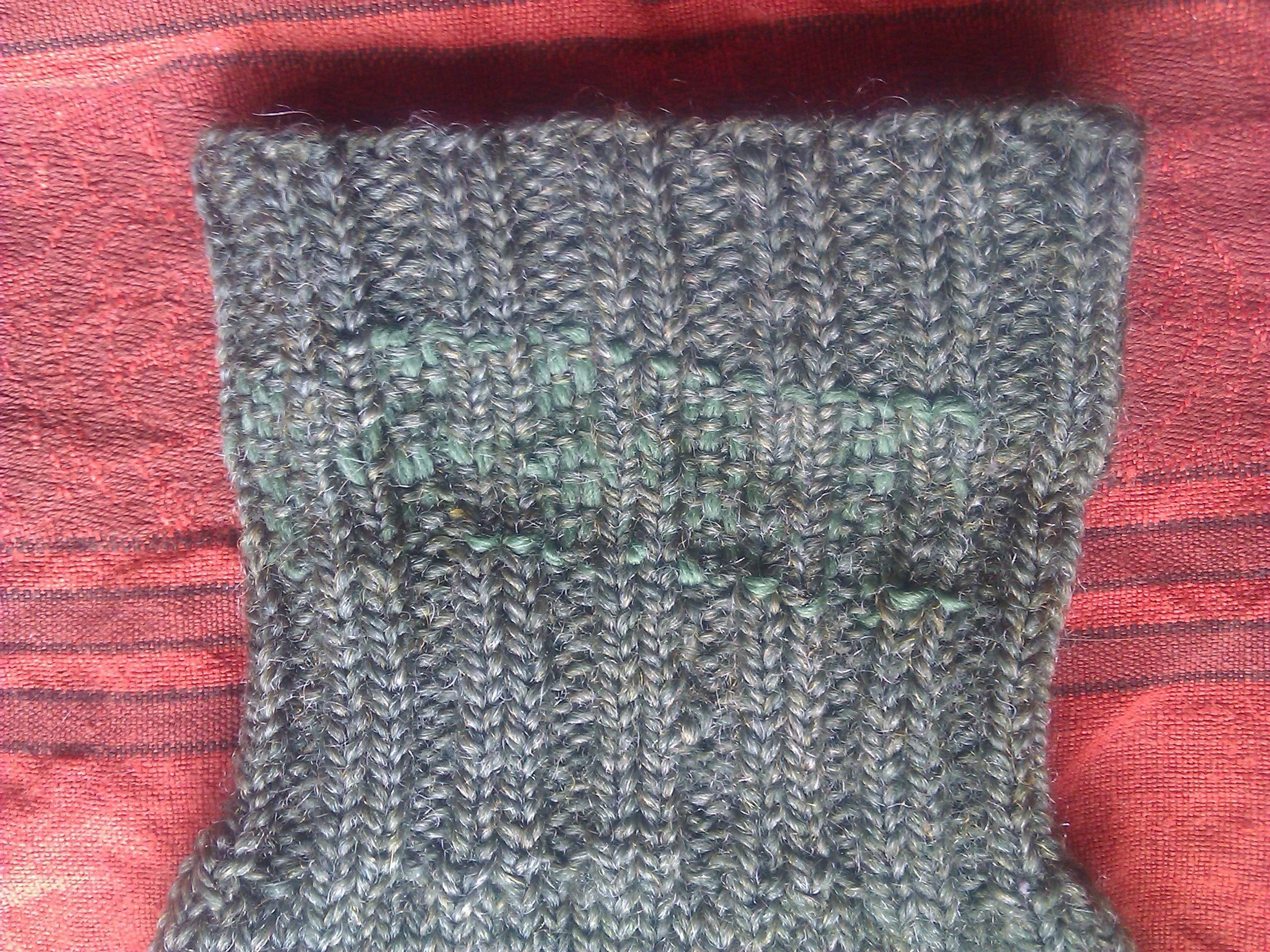
But at last it is finished. I am happy to say that the sleeve was saved: the darning not only captured any thread that was thinking of unravelling, but reinforced the whole worn area. It’s thick and sturdy now, I think it will survive.
Wikipedia describes the guernsey as “a particularly hardy item of clothing” and notes that “It is not uncommon for a guernsey to last several decades and be passed down in families.” I don’t know if my guernsey will last that long (though it is well into its second decade now), but I intend to give it every opportunity to do so.
Who knows? Maybe one day I will even have the guts to try Swiss darning. It’s certainly more beautiful than plain darning. Still, while my mend may not be pretty, it’s practical, and that’s what guernseys are all about. And I am glad that my practical skills can keep the guernsey together while it keeps me warm.

Today’s bit of Old-Fashioned wisdom is brought to you by the guernsey: Keep Warm and Carry On.